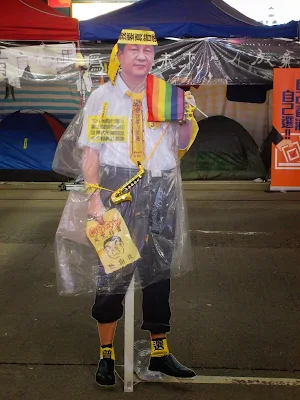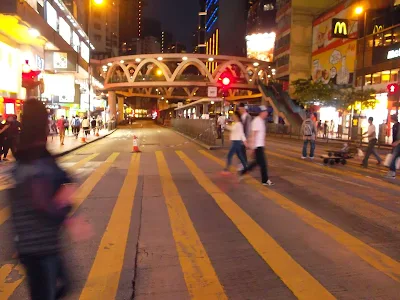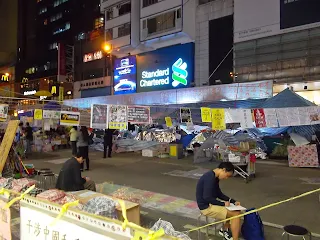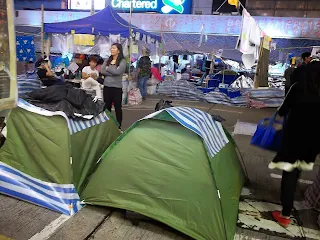Yesterday I arrived in Hong Kong and, despite being extremely tired - I had slept for only one hour and a half in two days -, after leaving my stuff at the hostel I immediately went to see how Occupy Central had transformed the city centre.
However, I was way too exhausted and hungry to go to Central, so I just had a look at the Causeway Bay site of the protest, which is quite close to where I'm currently staying.
However, I was way too exhausted and hungry to go to Central, so I just had a look at the Causeway Bay site of the protest, which is quite close to where I'm currently staying.
The 'Occupiers' have by now settled permanently in some limited areas, one of them being a section of Hennessy Road, formerly a bustling traffic artery, now turned into a sort of 'encampment' with tens, colourful pictures, collages and posters. Actually, Hennessy Road has never been as beautiful as it is today, and the occupation does not seem to affect shops or normal life. The only thing it has affected is traffic, but, well, does Hong Kong really desperately need more cars and pollution?
The atmosphere is quiet right now, and very little seems to be happening for the time being. This is another proof that these students are no rowdies that want to disrupt the life of Hong Kong. I can't think of a more peaceful manifestation of dissent in a city where the people have not been given a legal mechanism for changing a government they don't like.
So far, traffic disruptions have been limited. The means of transport which has suffered the most is probably the tram, which is the only one that can't change its routes to circumvent the 'occupied' areas.
Yesterday, I took a tram from North Point MTR Station to Central, but it didn't get that far and stopped at Victoria Park. This is now the last stop of all eastbound tram routes. At Victoria Park, trains have to change direction and go back. Obviously, the tram staff have to do quite a lot of extra work, not just to revert the tram's direction, but also to inform the puzzled passengers.
So far, traffic disruptions have been limited. The means of transport which has suffered the most is probably the tram, which is the only one that can't change its routes to circumvent the 'occupied' areas.
Yesterday, I took a tram from North Point MTR Station to Central, but it didn't get that far and stopped at Victoria Park. This is now the last stop of all eastbound tram routes. At Victoria Park, trains have to change direction and go back. Obviously, the tram staff have to do quite a lot of extra work, not just to revert the tram's direction, but also to inform the puzzled passengers.
Apparently, the occupation has turned into a tourist attraction by its own right, with numerous tourists - some of whom come from mainland China - taking pictures of the site. The many versions of the 'Occupy Central Xi Jinping' are among the most popular artworks (whether it is wise to mock the commander-in-chief of the same PLA that crushed the democracy movement in 1989, is another matter).
 |
 |
| 'democracy walls' all over the place |
 |
| "I want genuine universal suffrage", says Winnie-the-Pooh |
 |
| Chief Executive Leung Chun-ying and Chief Secretary Carrie Lam (right) |
 |
| 'Occupy the bus station' |
 |
| 'occupied' bus stop |
 |
| Over a month ago, this street was dominated by cars. Now, the people walk there as they please. |



















Comments
Post a Comment